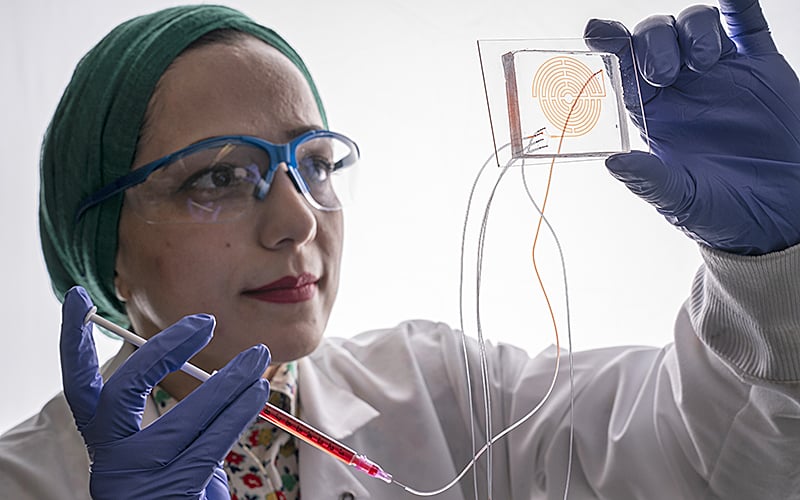Microfabricated Systems

Reducing the dimensions of flow channels, chemical reactors and separation units can offer advantages for many different chemical processes and analytical techniques. For example, Michigan chemical engineers are developing and using microfabricated devices to better understand the circulation of cancer cells, to do high-throughput synthesis, to put a chemical lab on a microchip and to design better ways to deliver drugs to targeted areas in the body.
Brendon Baker
The Baker lab studies how structure and mechanics of the cellular microenvironment guide fundamental cell processes such as migration, proliferation, and extracellular matrix synthesis. To do so, we use microfabrication technologies to create synthetic biomaterials that mimic the 3D, fibrous nature of stromal or interstitial tissues. Combined with molecular tools, live imaging, microfabrication/fluidic techniques, and multi-scale mechanical characterization, these materials allow us to model, study, and control the interactions between cells and their surroundings. Ultimately, we aim to 1) shed insight into extracellular matrix-mediated diseases such as cancer and fibrosis and 2) use material cues to direct cell function for tissue engineering and regenerative medicine applications.
Mark Burns
Professor Mark Burns and his group develop lab-on-a-chip devices for genetic analysis, blood tests, and diagnosing influenza and bacterial infections. The group’s studies in microfluidic systems include the development of modular systems, controlling flow with sound, and controlling pressure through temperature.
Mark Kushner
Professor Mark Kushner and his group develop computer-aided design tools that help semiconductor companies manufacture microelectronics better.
Computational Plasma Science and Engineering Group
Joerg Lahann
Professor Joerg Lahann’s research interest is focused on the development of active, multi-functional bio-interfaces, which are applicable to a range of biomedical applications. His group’s recent advances in the molecular design of active nanostructures include the introduction of reactive coatings, reversibly switching surfaces and anisotropic nanoparticles that support the vision of smart interfaces and act as templates in time-controlled surface interactions.
Sasha Cai Lesher-Pérez
Professor Sasha Cai Lesher-Pérez joined the Chemical Engineering faculty at the University of Michigan as an Assistant Professor in August 2022. The Lesher-Pérez Research Group leverages microfabrication, microfluidics, biomaterials and tissue engineered models to build microphyisiological models to study biorhythms and their role in disease and health mechanisms.
Albert Liu
Arming nano-electronics with mobility extends artificial systems into traditionally inaccessible environments. Quantum-confined nanoparticles (0D), carbon nanotubes (1D), graphene (2D) and other crystalline materials with well-defined lattice structures can be incorporated into polymer microparticles (i.e., colloidal electronics), granting them unique electronic functions. The Liu laboratory seeks to advance device capabilities for individual colloidal electronic particles, and explores higher-order assemblies of these building-blocks into hierarchical colloidal electronic matter. This research program, positioned at the intersection between materials design, chemical catalysis, and electronic device fabrication, aims to address one central challenge: Can we build materials the way nature builds us?
Laboratory of Emergent and Galvanically Orchestrated Systems (LEGOS)
Claudia Loebel
The Loebel lab develops and employs microscale engineering tools to recreate the complexity of biological systems. A current focus of the group is on the design of microstructured hydrogels to guide lung epithelial organoid self-organization and assembly and use these culture platforms to probe how cells within the lungs communicate with each other and their surrounding matrix.
Sunitha Nagrath
Professor Sunitha Nagrath’s research focus is the development of advanced MEMS tools for understanding cell trafficking in cancer through isolation, characterization and study of circulating cell in peripheral blood of cancer patients. Her group works on isolating and studying rare cells from cancer patients. These studies will progress to the design and development of smart chips that use microfluidics and nanotechnology to make an impact in medicine and life sciences.